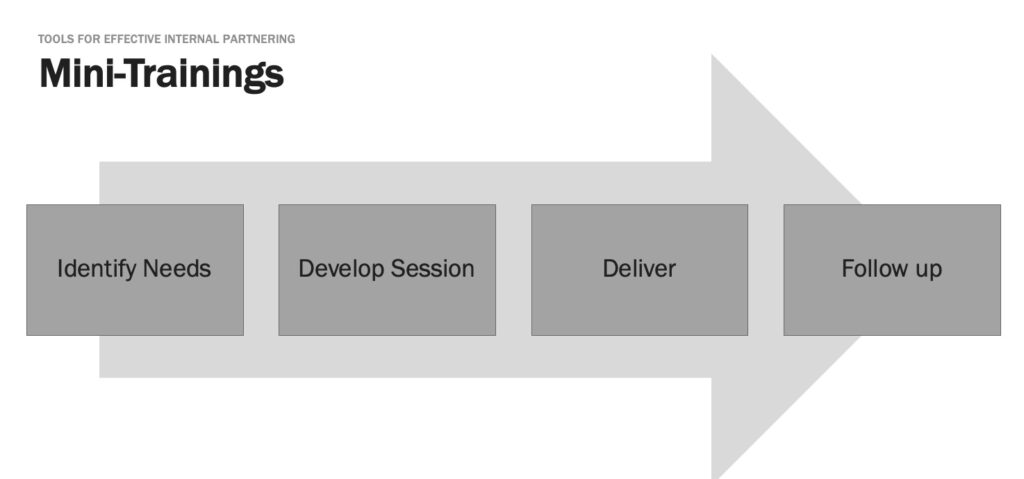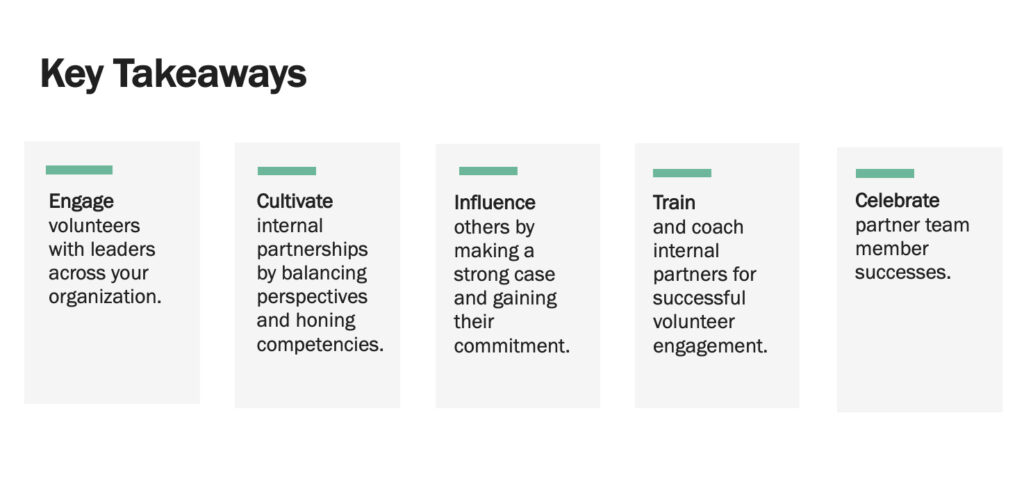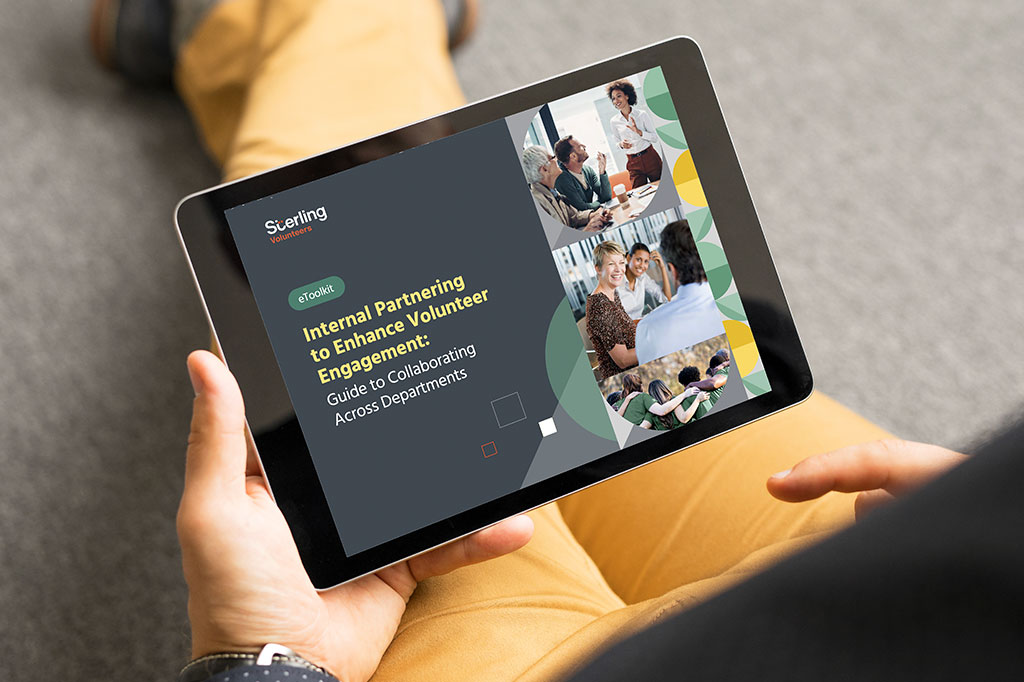May 1st, 2023 | Sterling
Tools for Internal Partnering to Enhance Volunteer Engagement

What Tools Can You Use to Boost Volunteerism?
Relationships matter, not only in business but also in nonprofit work. However, building those relationships can take effort and self-reflection. For example, when it comes to your departments and colleagues, what level of support, assistance, teamwork, and collaboration do you provide and receive? How can you grow and leverage the influence you have on these relationships? And how can you best manage conflict when it arises? Sterling Volunteers hosted a webinar in October where nonprofit industry expert Beth Steinhorn, President of VQ Volunteer Strategies, helped our webinar attendees to answer these questions and outlines actionable tips and tools you can use to nurture relationships that matter, influence without authority, and provide meaningful training to equip others for success. Let’s recap some of the practical advice from our webinar and learn how you can be a more effective internal consultant and partner, all with the goal of enhancing your volunteer engagement.
Navigating Organizational Paradox
Every organization has built-in conflicts between different sets of goals, all of which are valuable in their own way. Let’s call these conflicting goals “paradoxes”. Our webinar discussion focused on several types of paradoxes you must identify and resolve, including:
- Inside vs. Outside: Balance what’s happening inside the organization with what’s going on outside the organization. For example, balancing LLS needs with understanding and being aware of outside trends in engagement and volunteerism. Example: The Sector tells us volunteers want more short-term volunteer opportunities, and many of our departments have positions like committees that are expected to serve for full-year terms or longer.
- Individual vs. Organization: Balance both the needs of individuals and those of the organization. Example: balancing the needs of the volunteer with focus on the mission/business of LLS. Departments and OVE may have a volunteer who really wants to serve as a volunteer in a campaign but who doesn’t have the skills to successfully take on leadership tasks.
- Talent vs. Teamwork: Balance working individually with the need to work with others for success. Example: LLS needs both talented, capable individuals and teams that can work together effectively to provide services to communities in need. You need to balance providing professional development to enhance ED’s talents with investing in bringing teams onboard to collaborate for success through team skills such as delegation, effective leadership, and shared accountability.
- Process vs. Event: Managing isolated events and processes. For example, EDs are driven by hosting successful events, but you need to advocate for processes to ensure compliance and data tracking.
- Future vs. Past: Balance learning from the past with the ability to adapt. However, when you ignore the past, you risk re-living it. Example: trying out new ways to engage and support volunteers working from home or otherwise remotely (virtual technologies, etc.) vs. not forgetting some of the tried-and-true lessons of relationship-building and nurturing which need to translate into new technologies.
- Strategic vs. Administrative: You must be strategic in partnering with departments, but also have administrative/documentation responsibilities. For example, ask questions such as, “We need to have these larger, strategic conversations with departments about change, engagement, etc., but we also need to be able to answer administrative questions around technology, tracking, etc. How do we balance the administration while also ensuring we set aside time and attention to the strategic discussions/work?”
5 Competencies of Effective Internal Partners
Likewise, everyone in your organization contributes their own skills and talents, all of which are valuable to achieving your shared goals. It’s vital to recognize what you yourself bring to the table. How can you identify your own core competencies that can help you to be an effective partner within your organization?
- Strategic Resource: Understands and articulates how volunteer engagement is a strategic asset; is familiar with the larger context of the community and trends in the field; focuses on the future; and advocates for opportunities for the organization as a whole (not just for volunteer engagement)
- Systems Thinker: Creates usable systems, technologies, and tools for engaging and supporting volunteers across the organization.
- Credible Colleague: Brings relevant information forward; follows through; and earns trust through results.
- Change Leader: Inspires others through a compelling vision for volunteer engagement and demonstrated successes in practices to achieve that vision.
- Ability Builder : Equips others for success through training, coaching, resources, and support.
How Can You Influence Without Having Authority?
We all know it can be difficult to persuade people when you’re not their boss, manager, or supervisor. But there’s good news! Actually, as a volunteer leader, you’re able to influence your colleagues in many other ways. First it’s essential to:
- Garner Support for the idea of engaging volunteers as a way to solve certain problems.
- Inspire Others to care about engagement and do things differently.
- Seek Cooperation with departments to ensuring positive engagement experiences.
- Resolve Conflicts as they arise.
- Negotiate Resources and encourage others to allocate time for volunteer onboarding, supervision, and recognition.
Framework for Persuasion
You can also use many other tactics and approaches when ethically persuading and influencing others. Our etoolkit dives into some of the science behind persuasion to equip you with some of these tactics. Meanwhile here’s a basic framework that you can use when working with other departments in your organization: Step 1: Set the Stage When you set the stage, you want to be sure you first know the purpose of the meeting before you then communicate it to your internal partners. For example you may want to describe a new volunteerism campaign, project, or tactic. Step 2: Appeal to Your Audience and Make Your Case The next step is to appeal to your audience and make your case. Establish the need (convince them that there is a problem) while getting their attention. Then introduce your solution(s). Through negotiation and discussion together, visualize the future. Describe what the situation will look like if the audience does nothing, and how this will specifically negatively impact them. Step 3: Get Agreement and Commitment Our last step is to develop a plan and get agreement/commitment. When developing a plan, it’s important to consider the team’s input, get agreement, and identify the barriers as well as the resources needed to fulfill the plan. For example, you might say, “How can we move this plan forward so that our shared vision and plan gets carried out as we’ve just outlined them? What are your suggestions?” Your team’s resourcefulness and creativity will often surprise you!
Use Mini-Trainings to Train Others for Partnership:

Mini-Trainings are meetings lasting 30 minutes or less, focusing on one discrete topic, tool, or practice. Later you can follow up.
- Identify training needs
- Develop your session – determine the ideal way to share information, and then develop and prepare your curriculum
- Deliver training
- Follow up – to take place immediately following the session, then 2-3 post-trainings
Engage, Influence and Celebrate!

It’s not easy to engage volunteers with the leaders across your organization—but it is rewarding in terms of your nonprofit achievements and teamwork. Toward this end, work to cultivate your internal partnerships by balancing perspectives and honing competencies. Try to influence others by making a strong case and gaining their commitment. Meanwhile, boost successful volunteer engagement by training and coaching your internal partners for successful volunteer engagement. After all your efforts, be sure to celebrate your successes with your partners and team members!
Watch This Webinar On-Demand

To learn more, watch the “Internal Partnering to Enhance Volunteer Engagement” webinar and download the new eToolkit, “Internal Partnering to Enhance Volunteer Engagement: Guide to Collaborating Across Departments.” The eToolkit features a chart you can use to identify and improve your primary business partner relationships to drive greater volunteer engagement. For more information, please visit sterlingvolunteers.com. Connect with us Facebook, Twitter, LinkedIn.
This content is offered for informational purposes only. First Advantage is not a law firm, and this content does not, and is not intended to, constitute legal advice. Information in this may not constitute the most up-to-date legal or other information.
Readers of this content should contact their attorney or lawyer to obtain advice concerning any particular legal matter. No reader, or user of this content, should act or refrain from acting on the basis of information in this content without first seeking legal advice from counsel or lawyers in the relevant jurisdiction. Only your individual attorney or legal advisor can provide assurances that the information contained herein – and your interpretation of it – is applicable or appropriate to your particular situation. Use of, and access to, this content does not create an attorney-client relationship between the reader, or user of this presentation and First Advantage.

